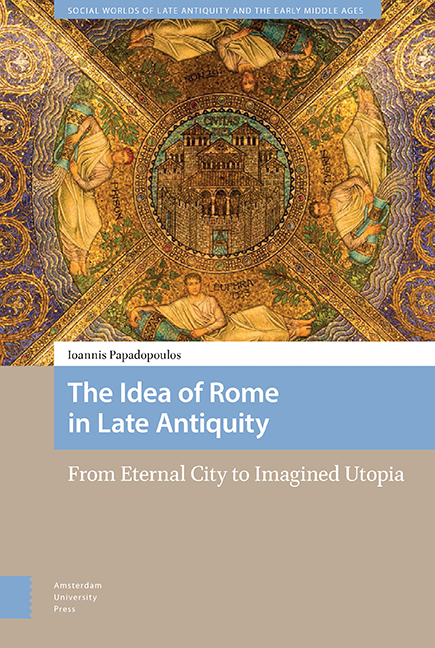Book contents
- Frontmatter
- Dedication
- Contents
- Introduction: Between a Physical and an Imaginary City
- I Looking Backwards: Ordo Renascendi
- II The Adventus of Constantius
- III Between Rome and Athens: The Artificial Romanitas of Julian
- IV Between the Altar and the Court: Symmachus and Claudian in Action
- V Between Christ and a Roman Place: The Emergence of Christian Rome in Time and Space
- VI Between Jerusalem and Babylon: The Archetype of Rome in the City of God
- Conclusions: From Rome to Eternity
- Bibliography
- Index
Introduction: Between a Physical and an Imaginary City
Published online by Cambridge University Press: 11 November 2021
- Frontmatter
- Dedication
- Contents
- Introduction: Between a Physical and an Imaginary City
- I Looking Backwards: Ordo Renascendi
- II The Adventus of Constantius
- III Between Rome and Athens: The Artificial Romanitas of Julian
- IV Between the Altar and the Court: Symmachus and Claudian in Action
- V Between Christ and a Roman Place: The Emergence of Christian Rome in Time and Space
- VI Between Jerusalem and Babylon: The Archetype of Rome in the City of God
- Conclusions: From Rome to Eternity
- Bibliography
- Index
Summary
Rome: Deconstructing an Idea
There has been a rising interest in and multiple publications regarding the role of cities as habitats, theatres of events and ideological workshops, hosts of forces of change in contemporary history, and survivors against all odds in a post-industrial world, which often exceed the norms of the established field of Urban Studies. Various works, such as P. Virilio's City of Panic (2007), the World City by D. Masses (2007), and S. Graham's Cities under Siege (2011) are only samples of a constantly expanding bibliography on the subject. The cities of pre-modern Europe also played a crucial role in reflecting and epitomizing human culture and ideas. The Sovereign-City in the form of city-state, head of confederate league, or imperial capital has dominated the Mediterranean landscape for millennia. While the old Brownian maxim that describes Greco-Roman civilization as ‘a world of cities’ maybe sound like a generalization, it is, in fact, a convincing summary of how cities function as the core of classical culture and institutions. Within the frame of this complicated relationship between the cities and their inhabitants is a bond of dependence, which has long been studied and celebrated in social sciences and literature, from G. Simmel's Die Gro.stadte und das Geistesleben (1903), L. Mumford's The City in History (1961), to I. Calvino's Citta Invisibili (1972), and T. Fuhrer, F. Mundt and J. Stenger's (eds.) Cityscaping (2015). One must therefore consider how ideas represent cities and vice versa, interconnecting, interrelating, and, finally, contributing to the shaping of new mentalities by adapting and adjusting to changing physical and spiritual needs. From that point of view, the city of Rome during late antiquity appeared to have a unique cultural and ideological importance in terms of the abstract and complex relationship that developed between the urban landscape, its inhabitants, and their identity and feelings as Romans of Rome. The eternal city embodied and reflected different ideas to various audiences, yet the symbolism and cultural burden of Rome as patria communis was omnipresent in late-Roman thought. This tension evolved rapidly and was becoming increasingly complex as we move towards late antiquity. We will observe how, by the fourth century AD, Rome, as archetype of the ideal/utopian city, was difficult to distinguish from the concept of Romanitas (Roman-ness), since by then both were evolving side by side, following each other on new ideological pathways.
- Type
- Chapter
- Information
- The Idea of Rome in Late AntiquityFrom Eternal City to Imagined Utopia, pp. 9 - 56Publisher: Amsterdam University PressPrint publication year: 2021



